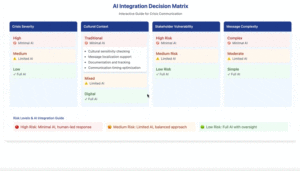Sunday, July 06, 2025
Sunday, July 06, 2025

by Philippe Borremans:
The question of when AI should be used in crisis communication strategies lies in the tension between efficiency, empathy, and precision. AI can monitor sentiment in real time, provide multilingual support, and even predict emerging crises (1) .
But successful crisis communication has always been about more than just tools. It’s about connection, trust, and making sure those involved feel seen and heard.
This is where the Universal Adaptive Crisis Communication (UACC) framework©, which I am currently working on, could provide guidance and bring structure and meaning to the chaos of crisis response.
My design for the UACC framework is based on five pillars: comprehensive stakeholder engagement, permacrisis integration, balanced communication, cultural awareness, and emotional intelligence. It does not see technology as a substitute for human judgement but as an enabler of more adaptable and targeted communication.
A central aspect of this approach is the AI Integration Matrix, a (draft) decision-making “tool” designed to help communicators determine when, where, and how AI should complement human efforts in a crisis.

An interactive version of the decision matrix.
By assessing four dimensions – severity of crisis, cultural context, vulnerability of stakeholders and complexity of message – the matrix ensures that AI is used to enhance, not diminish, the human touch.
It is a practical framework for balancing innovation and human touch, which is at the heart of effective crisis communication.
A structured approach to crisis communications response
The AI Integration Matrix is closely aligned with the principles of the UACC framework. It guides communicators to consider the specific requirements of each crisis before deciding on the balance of AI and human intervention.
Crisis severity
High-severity crises (disasters, major cyberattacks, etc.) require human-led communication supported by the analytical speed of AI. AI could monitor social media for urgent issues, translate important updates, or recognise patterns in resource allocation.
In contrast, low-risk events, such as routine service updates, can often be managed entirely by AI, with humans only intervening when necessary.2
The UACC emphasises adaptive strategies that ensure the response evolves as the crisis develops. The matrix reflects this by calling for the role of AI to be reassessed at each stage.
Cultural Context
Cultural awareness is a cornerstone of the UACC framework, and the matrix helps organisations manage different audience expectations.
In traditional environments, human-led communication is essential to maintain trust, while AI supports in the background with translations, localisations, and cultural sensitivity checks.
In digital contexts, AI could take the lead by using real-time analytics to deliver tailored messages across multiple platforms.
This integration ensures that the technology enhances the emotional intelligence required to manage complex cultural dynamics.
Stakeholder vulnerability
The matrix is consistent with UACC’s commitment to comprehensive stakeholder engagement, particularly for vulnerable groups. In public health emergencies or scenarios involving vulnerable populations, human care is prioritised.
AI serves as a logistical ally – tracking resources, managing schedules, and automating routine communications – while humans provide the empathy and connection that build trust.
In low-risk contexts, such as routine stakeholder updates, AI shines with its automation capabilities, providing efficiency without sacrificing clarity.
Message complexity
The matrix also takes message complexity into account, emphasising UACC’s focus on balanced communication.
Highly complex scenarios, such as policy changes, require a human-crafted message to ensure clarity and nuance. This is where AI plays a supporting role by providing data analytics or tone of voice checks to optimise the process.
For simple updates, AI can manage the writing, sending, and monitoring of engagements semi-independently.
Integrate AI without losing the human touch
The guiding principle of the UACC framework is that technology should support, not replace, the human elements of crisis communication.
The AI integration matrix embodies this philosophy and encourages organisations to think critically about where AI can add value without sacrificing cultural awareness or emotional intelligence.
Consider a health emergency involving vulnerable populations in culturally diverse regions. The UACC framework would guide human communicators to prioritise emotional support while using AI for localisation, resource allocation, and stakeholder segmentation.
Alternatively, a moderate crisis such as a product recall in a digitalised market could require a hybrid approach: AI takes care of handling customer enquiries and complaints, while human teams can focus on broader strategy and messaging.
Building trust through thoughtful deployment
As crises become more complex, the UACC framework and AI integration matrix together could provide a blueprint for effective communication. They would ensure that decisions about AI integration are practical and purposeful, fostering trust and connection at every stage.
When should we use AI in crisis communications?
When it complements the core values of the UACC framework – empathy, adaptability, and cultural understanding – and supports the ultimate goal: a response that feels as human as it is effective.
What do you think?
___
References and further reading:
1 Alheadary, W. G. (2023). Artificial Intelligence Metamodel for Controlling and Structuring the Crisis Management Domain. Journal of Computer Science, 19(8), 988–997. https://doi.org/10.3844/jcssp.2023.988.997
2 Oana-Mihaela VLADU. (2023). DIGITAL TRANSFORMATION IN CRISIS MANAGEMENT: THE KEY ROLE OF ARTIFICIAL INTELLIGENCE. SCIENTIFIC RESEARCH and EDUCATION in the AIR FORCE, 24, 103–110. https://doi.org/10.19062/2247-3173.2023.24.15
+++
Philippe Borremans is an independent consultant in risk, crisis, and emergency communication with 25+ years’ experience supporting health agencies, governments, and corporations. He authored Mastering Crisis Communication with ChatGPT and produces the Wag The Dog newsletter and podcast.
Written by: Editor
© 2025 Stratpair Ltd., trading as Strategic. Registered in Ireland: 747736